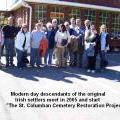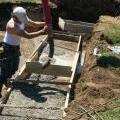Most Montrealers believe that all of the Irish immigrants to our city arrived at the time of the Irish Famine in 1847, when in reality the ancestors of many of our present day Quebec citizens of Irish descent likely arrived decades before this terrible event.
 One large Irish group reached our shores in the early 1820s. They were predominantly Catholic farmers and were looking for new opportunities, as the agricultural prices in Ireland decreased drastically after the Napoleonic wars. These newly arrived Irish men, women and children were so numerous that they began to overflow all of the Catholic Church services, particularly at the Old Bonsecours Church.
One large Irish group reached our shores in the early 1820s. They were predominantly Catholic farmers and were looking for new opportunities, as the agricultural prices in Ireland decreased drastically after the Napoleonic wars. These newly arrived Irish men, women and children were so numerous that they began to overflow all of the Catholic Church services, particularly at the Old Bonsecours Church.
Their religious needs were originally administered by Father Richard Jackson, an American, but eventually the Catholic authorities in Montreal decided that they should find an Irish priest who would have a better understanding of the Irish language & customs. The Church located Father Patrick Phelan (who later became a Bishop in Kingston, Ontario). Father Phelan had been born in Ireland, immigrated to Boston, came to the Grand Seminary in Montreal to study theology, and in 1825, was the first priest ordained by Msgr. Lartigue, Bishop of Montreal.
Patrick Phelan also became a member of the Gentlemen of St. Sulpice (the Sulpicians) who were the Seigneurs of a great deal of property in Two Mountains, north on Montreal. Father Phelan felt that his Irish flock should have a community of their own and since the majority of these immigrants were farmers, he approached his religious order to provide some land in the northern part of Two Mountains, an area basically unsettled, to set up this new community.
This community became known at St. Columban (the present day spelling is St. Colomban) and is located about 40 miles from Montreal and not far from St. Jérome. Although less than an hour from Montreal by car today, it was some distance in the early 1800s and required long travel by stagecoach, raft and by foot to reach the settlement.
Originally the settlers were attached to the Parish of Ste. Scholastique (about 9 miles away). However, after some negotiations and arguments with Church authorities, these Irish settlers managed to have a church built and to have St. Columban become its own parish in 1835. St. Columban was likely the first Irish Catholic Church in Quebec that was independent and that recorded their activities (births, deaths, marriages, and so on) in English. (St. Patrick’s in Quebec City was founded about the same time, but was a part of the Notre Dame Church in that city. The St. Patrick Church in Montreal was founded a number of years later.)
From its founding in 1835 until about the early 1900s, St. Columban remained an almost exclusively Irish and Catholic community, reaching at its peak about 250 families in the area. However, most of the land was not easy to farm and with large Irish families there was not enough good land to divide among the next generation.
By the 1880s Montreal had grown to about 130,000 inhabitants, and the next generation in St. Columban found that the city offered more employment and other opportunities than in the small farming community. Slowly, this generation started to move to Montreal and other locations in Ontario and the United States.
 Although some descendants of the original Irish settlers were still in St. Columban in the 1960s, the “Irishness” and early history of the settlement was generally forgotten. In 2005, some of the Montreal descendants of these first Irish settlers, with an interest in their roots, connected and visited present day St. Columban. They were dismayed to find that a number of the original Irish tombstones from the St. Columban Cemetery had been unceremoniously thrown in the bush, up behind the local Catholic Church. Many of these stones, almost 200 years old, had simply fallen victim to ravages of time, general neglect and a basic lack of interest in the story of history that they told. These descendants immediately started the “The St. Columban Cemetery Restoration Project.”
Although some descendants of the original Irish settlers were still in St. Columban in the 1960s, the “Irishness” and early history of the settlement was generally forgotten. In 2005, some of the Montreal descendants of these first Irish settlers, with an interest in their roots, connected and visited present day St. Columban. They were dismayed to find that a number of the original Irish tombstones from the St. Columban Cemetery had been unceremoniously thrown in the bush, up behind the local Catholic Church. Many of these stones, almost 200 years old, had simply fallen victim to ravages of time, general neglect and a basic lack of interest in the story of history that they told. These descendants immediately started the “The St. Columban Cemetery Restoration Project.”
 Over the last five years, this group has managed a number of fundraising efforts to start the cemetery restoration project, with the objective of raising an additional $5,000, and completing the basic work in the spring of 2010. This would coincide with the 175th anniversary of the founding of St. Columban.
Over the last five years, this group has managed a number of fundraising efforts to start the cemetery restoration project, with the objective of raising an additional $5,000, and completing the basic work in the spring of 2010. This would coincide with the 175th anniversary of the founding of St. Columban.
The web site of the St. Columban Cemetery Restoration Project, at www.stcolumban-irish.com, provides a great deal of information about the early settlers in the area, and about recent efforts to repair the cemetery.